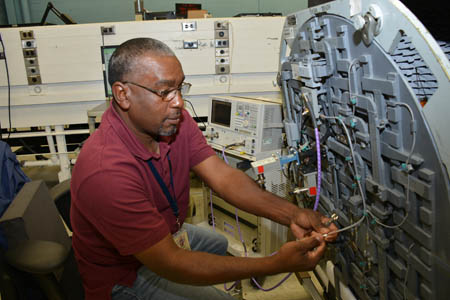
Oct. 2, 2013— 2014 budget deliberations have hit a roadblock, thousands of Air Force civilians are temporarily furloughed, and the federal government is partially shut down. Now what
2014 budget deliberations have hit a roadblock, thousands of Air Force civilians are temporarily furloughed, and the federal government is partially shut down. Now what
That’s exactly what Air Force officials are working to figure out. It might take a few days to know the answers.
“In the immediate [timeframe], not having [Air Force] civilians here has caused extreme disruptions for our mission, in general,” said Air Mobility Command spokesman Capt. James Nichols on Tuesday. “However, we’re still able to carry on. It may take a couple of days for us to really be able to look out and clearly see the impact,” he said.
The Defense Department will determine what missions are essential and which ones can be pushed to the back burner, said Nichols. However, nothing has been cancelled “yet,” he said.
“It’s a continuous thing. It’s a day-to-day kind of deal,” he continued. “Right now, it’s all kind of fresh and new and we are trying to get our bearings straight.”
As for Air Combat Command, overall missions are “curtailed” as a result of the shutdown, though all ACC bases “will continue some level of activity,” ACC spokesman MSgt. Randy Redman told the Daily Report on Oct. 1.
Redman said personnel supporting named operations are considered exempt and will report to duty as normal. “In other words, if units are deploying from now through January, they will be flying at the level needed to achieve and sustain full combat readiness,” he said.
Flying training units also will continue to fly if students are “immediately needed to support operational taskings,” he said. This includes F-22 training, MC-12 training, and remotely piloted aircraft training. In addition, urgent operational test and some other test activities also will continue, he said.
“Civilians directly supporting these excepted activities will continue to work as needed during the duration of the government’s shutdown,” said Redman. “Should the current shutdown persist, we may need to bring additional personnel back to work in order to continue to support operational requirements.”
President Obama signed a law late Monday exempting uniformed personnel and some federal civilians from the furloughs. The last minute effort means some personnel will still get paid—and on time. But, it also means those left behind will have to bear a significantly heavier workload.
Air Education and Training Command spokesman Lt. Col. Sean McKenna said the vast majority of Air Force training would continue without delay. However, the shutdown will still have a “great effect” on the command, he said, which is made up of some 63,000 personnel—about a quarter of whom are civilians.
“There is a big impact because you are missing a lot of the workforce. In my small office, more than half [of the staff members] are civilians,” said McKenna. “In our wings . . . there often are more civilians than ‘blue suiters’ in the offices.”
The Air Force Institute of Technology, in particular, has many civilian instructors, so class time will be limited, he noted. Students have been instructed to continue working on their thesis statements until the budget stalemate is broken and their instructors return to work.
Roughly 77 percent of Air Force Materiel Command’s workforce is made of civilians. It’s still not clear exactly who among them will be exempt from the furloughs, said Michelle Martz, a command spokeswoman, who spoke to the Daily Report before shuttering her own office on Tuesday.
“We’ll have a better idea in a couple of days. Operationally, they have a little better picture. Our depots fall under the Working Capital Fund, so they are not affected, at least not initially,” said Martz.
Air Force headquarters spokeswoman Ann Stefanek said some activities in the Air Force would continue to receive funding despite the shutdown. For example, AFMC employees whose paychecks are funded by the WCF are safe until the fund runs dry, she said.
Work that directly supports combat activities and military operations also is exempt, as would be anything funded with prior-year or multiyear money, she said.
Defense Secretary Chuck Hagel told reporters traveling with him in South Korea on Tuesday that Defense Department lawyers “believe that maybe we can expand the exempt status,” bringing more civilians back to work.
Hagel said the Pentagon would make every effort to call back as many civilian employees as possible.
“Even though we are exempted, our military has no budget,” said Hagel. “We are still working under this dark cloud of uncertainty not knowing what’s going to happen. This reflects on our missions around the world. It reflects on our allies questioning our commitments. It affects our planning as we are in the process . . . of preparing a 2015 budget,” he said.
On Tuesday, notices appeared at many Air Force websites and social media sites that new postings at these sites would not be coming until the shutdown is over. Stefanek said one exception is the main Air Force website (www.af.mil) where shutdown-related updates will continue to appear.
The National Museum of the US Air Force in Dayton, Ohio, announced on Oct. 1 it had temporarily closed its doors due to the shutdown.
The congressionally mandated commission studying the Air Force’s force structure has postponed several public hearings.
The Civil Air Patrol, however, said it would continue to perform emergency and disaster-response missions during the shutdown.